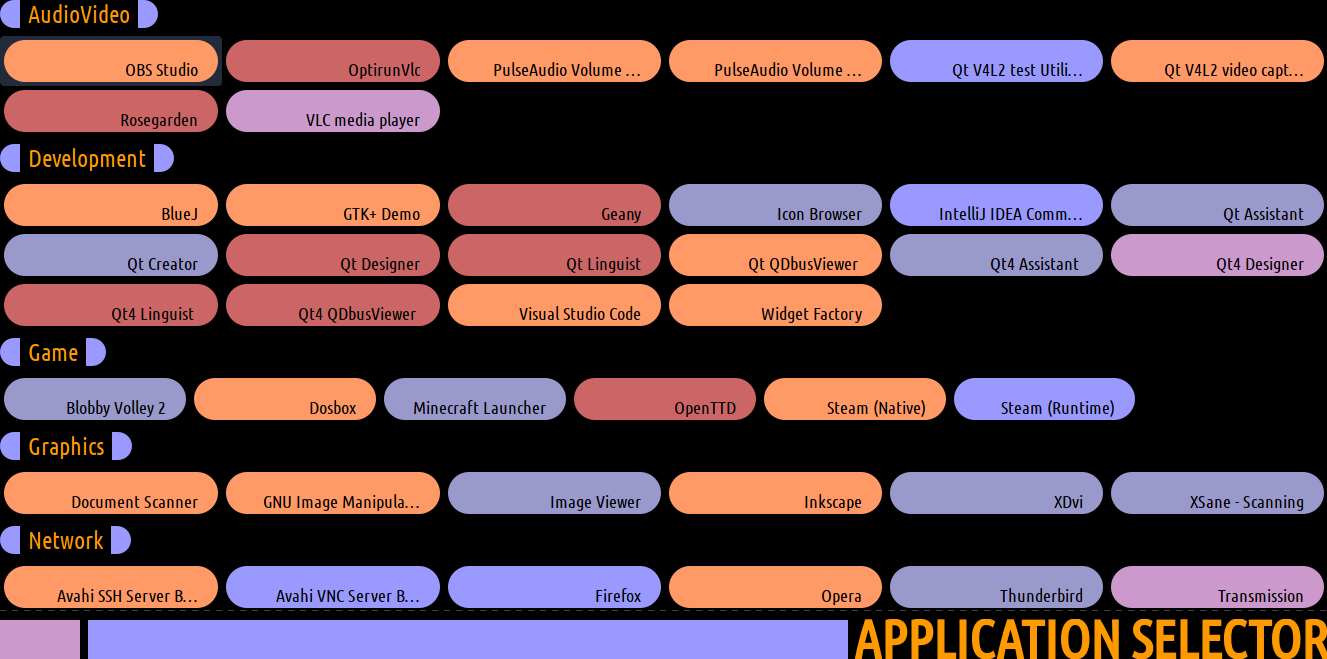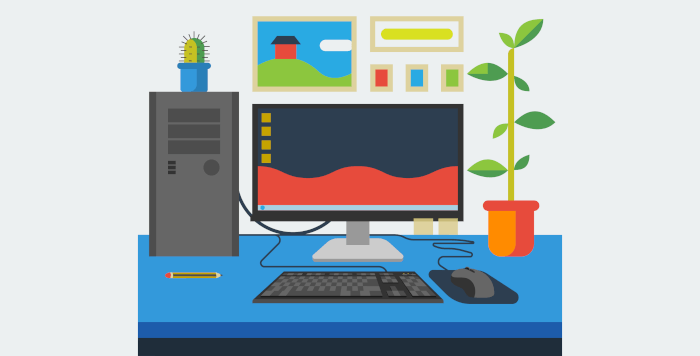LCARS Desktop Environment, official project name lcarsde, is a desktop environment that mimics the LCARS interface. LCARS is an acronym for Library Computer Access/Retrieval System, a computer operating system which features in the Star Trek: The Next Generation series.
The desktop environment consists of a window manager that is based on Xlib as well as a set of tool applications, which are a menu of active open applications, the status bar, a program selection and an application for logout, shutdown, etc. lcarsde does not provide its own display manager.
lcarsde consists of five parts:
- LCARS Window Manager – a stacking window manager and displays one window at a time per screen. Windows always open on the primary monitor and can be moved to other monitors with keyboard shortcuts. lcarswm has two kinds of monitors, one primary monitor (which maps to the X primary monitor) and “other” monitors. Only the primary screen has the upper (currently empty) information area and the side bar that shows the app menu. The information area and the app menu are only visible in the normal screen mode. There are three screen modes
- Application Menu – lists all open windows and allows to focus or close them.
- Status Bar – shows some system information like CPU usage and connectivity status and offers some buttons to perform actions like open a program or adjusting the sound.
- Application Selection – lists all installed programs (with a desktop file) in their categories and allows to run them by clicking on the programs button. In the default status bar configuration, this application is available via the button that is labeled “programs”.
- Logout Application – offers buttons for logout, shutdown, restart, … . In the default status bar configuration, this application is available via the button that is labeled “close”.
This is free and open source software.
Website: lcarsde.github.io
Support: GitHub Code Repository
Developer: Andreas Tennert
License: GNU General Public License v2.0

The different parts are written in Kotlin. Learn Kotlin with our recommended free books and free tutorials.
| Popular series | |
|---|---|
| The largest compilation of the best free and open source software in the universe. Each article is supplied with a legendary ratings chart helping you to make informed decisions. | |
| Hundreds of in-depth reviews offering our unbiased and expert opinion on software. We offer helpful and impartial information. | |
| The Big List of Active Linux Distros is a large compilation of actively developed Linux distributions. | |
| Replace proprietary software with open source alternatives: Google, Microsoft, Apple, Adobe, IBM, Autodesk, Oracle, Atlassian, Corel, Cisco, Intuit, and SAS. | |
| Awesome Free Linux Games Tools showcases a series of tools that making gaming on Linux a more pleasurable experience. This is a new series. | |
| Machine Learning explores practical applications of machine learning and deep learning from a Linux perspective. We've written reviews of more than 40 self-hosted apps. All are free and open source. | |
| New to Linux? Read our Linux for Starters series. We start right at the basics and teach you everything you need to know to get started with Linux. | |
| Alternatives to popular CLI tools showcases essential tools that are modern replacements for core Linux utilities. | |
| Essential Linux system tools focuses on small, indispensable utilities, useful for system administrators as well as regular users. | |
| Linux utilities to maximise your productivity. Small, indispensable tools, useful for anyone running a Linux machine. | |
| Surveys popular streaming services from a Linux perspective: Amazon Music Unlimited, Myuzi, Spotify, Deezer, Tidal. | |
| Saving Money with Linux looks at how you can reduce your energy bills running Linux. | |
| Home computers became commonplace in the 1980s. Emulate home computers including the Commodore 64, Amiga, Atari ST, ZX81, Amstrad CPC, and ZX Spectrum. | |
| Now and Then examines how promising open source software fared over the years. It can be a bumpy ride. | |
| Linux at Home looks at a range of home activities where Linux can play its part, making the most of our time at home, keeping active and engaged. | |
| Linux Candy reveals the lighter side of Linux. Have some fun and escape from the daily drudgery. | |
| Getting Started with Docker helps you master Docker, a set of platform as a service products that delivers software in packages called containers. | |
| Best Free Android Apps. We showcase free Android apps that are definitely worth downloading. There's a strict eligibility criteria for inclusion in this series. | |
| These best free books accelerate your learning of every programming language. Learn a new language today! | |
| These free tutorials offer the perfect tonic to our free programming books series. | |
| Linux Around The World showcases usergroups that are relevant to Linux enthusiasts. Great ways to meet up with fellow enthusiasts. | |
| Stars and Stripes is an occasional series looking at the impact of Linux in the USA. | |

Beautiful!
—
Star Trek: TNG is my favorite in the series.
I still prefer Star Trek TOS but that wouldn’t make for a great desktop environment 🙂
TNG had a few really nauseating characters.
Who are these characters that you label nauseating?
Wesley Crusher, Q, and Lwaxana Troi.
I agree regarding WC but I didn’t mind LT. Besides, neither were central characters.
I never said they were central characters. But WC appeared regularly in Seasons 1-4 and as a guest for seasons 5 & 7. Wikipedia considers the character as one of the main cast, and the other two are recurring characters.
I really like Majel’s character in TOS.
I know, I just meant that since they weren’t central characters [LT might just barely fit that criteria], I didn’t see it as being a major issue.
I enjoyed the episodes with Q.
Perhaps just watch the episodes without them or at least episodes with just one of them.
Way offtopic I know, but Alex, what’s your fav TOS episode?
There are so many great episodes for both TOS and TNG. For TOS, my personal fav is “The City on the Edge of Forever”.
Not that keen on the fact you have to install each component separately, but it all compiles fine on Arch.
While the intention of the project is commendable, the desktop gets in the way of my workflow. Back to Plasma.
Yes, I’d prefer a single package but it installs on Manjaro with no issue. I’ve yet to try it under Ubuntu. The project provides packages for Ubuntu 22.04, but I’m mostly using 24.04 these days.